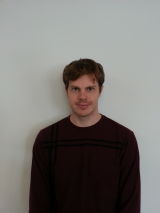Christopher Deeks
 About Me
About Me
2012-13 – MSC Complexity Science, University of Warwick Centre for Complexity Science
2011-12 – Principal Engineer, MBDA
2010 (Secondment) - Systems Engineering Innovation Centre, Loughborough University
2009 (Secondment) - Technology Exploitation, BAE Systems InSyTe
2006-11 - Research Scientist, BAE Systems Advanced Technology Centre
2001-05 - Master of Mathematics, Warwick Mathematics Institute
My Research
Complexity Science Doctoral Training Centre:
MSc Miniproject One (Mar-Jun 2013): Networks of Q-Learners (with BT Technology: Wireless Research and Warwick Business School)
Investigating the use of network of learning agents called Q-learners to allow wireless to adjust frequencies to minimise interference in increasing tightly packed urban spaces. Given the connection between the number of non-overlapping frequencies used by neighbouring routers and the graph colouring problem, this problem could be solved by simulating a network of Q-learners on each graph node and identifying the chromatic number for that network. This project investigated the feasibility and performance of Q-learners for this task compared against alternative previous approaches, concluding that they were efficient at reducing network conflict but generally inefficient when it came to usage of spectrum.
MSc Miniproject Two (Jun-Sep 2013): Area Surveillance and Target Tracking (with Thales UK: Systems, Research and Technology and University of Warwick Computer Science Department)
Investigating the merits of different algorithms for determining the flight paths for surveillance drones, and simulating a number of sample paths. The cost of conducting a surveillance operation is in large part driven by the operating cost of the platform used, hence a cost function was calculated for characteristically different strategies (one large or multiple small) from integrating over the sample paths generated. Once platform costs were factored in, a threshold where larger aircraft were more cost effective than multiple small platforms. However, it was unresolved whether this might be more a characteristic of the geometrical constraints of the simulation used.
Previous Research:
My primary research interest is in modelling the behaviour of multi-agent systems operating in stochastic environments under uncertainty. Importantly though, my goal is to predict and/or quantify the extent or bound of the collective system behaviour with little a priori constraint on agent’s control policy, to make feasible the application of agent-based technologies in a far wider application domain. Specific aspects of this research have or will include:
• Decomposition of multi-agent systems into control hierarchies and the impact this has of collective behaviour
• Application of fractal geometry to the problem representing the system’s span in phase space
• Investigate the hypothesis that phase transitions in collective behaviour are related to random fractals
Other previous research:
• Design of an algorithmic approach to crowd behaviour and crush formation inspired by cellular automaton; further development of this approach to consider variable granularity lattices, 3-dimensional spaces, and variably scaled time remain to be done
• The use of Markov Decision Processes, and their execution though networks of learning agents (Bellman-esque V-learners or the more recent Watkins Q-learners) to provide a generic modelling tool for a range of complex systems, to enable safety certification of such systems
• Feasibility of representing patterns of behaviour using formal grammars, encoding sequences of actions and response to determine patterns revealing of “speaker’s intent”
I also have a ‘black book’ of project ideas, either my own ideas or things colleagues have challenged me to address over the years. In addition to the above, some particular challenges on my to-do list include:
• Identify an appropriate mathematical framework for formalising UML, to enable analytical extrapolation of likely emergent properties from initial system designs (symbolic logic and/or category theory may provide part of the answer)
• Demonstrate algorithms capable of safely managing real-time control reconfiguration (without relying on the short cut of prior determination of the likely change) Assuming some constraints remain necessary, explore how far these constraints can be pushed
• Investigate whether my earlier work on modelling complex systems can usefully be extended to human systems
• Consider how to provide assurance of information security in a mobile ad hoc networks where common assets exist in multiple networks (possibly representing networks using hypergraphs)
• Consider how to make intelligent fault diagnostics robust to complex systems lacking a causal link between component faults and system failures
• Complete an unfinished (collaborative) piece of mathematical modelling for so-called “structured-temporal models of swarm behaviour” that was intended to provide an analytic framework for conducting further research into swarm behaviour
